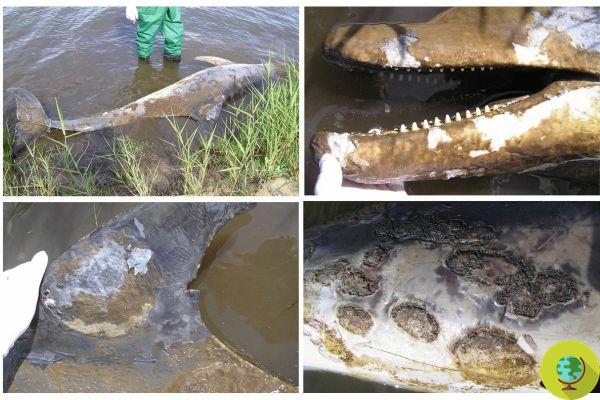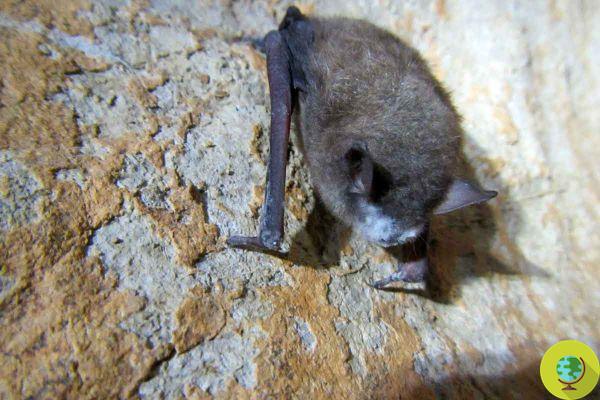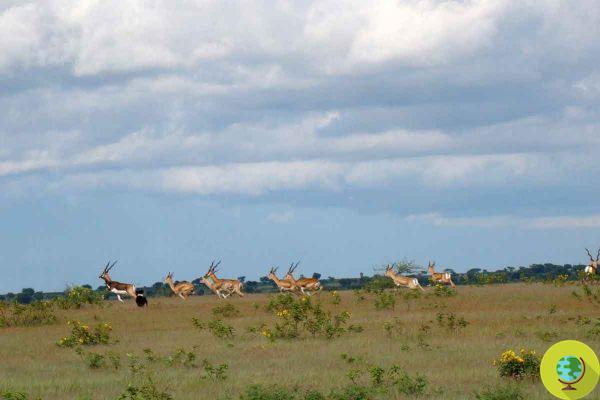Human actions cause disease in wild animals and drive species to extinction a thousand times faster.
He is about to end up run over, his mother saves himThe actions of humans - such as habitat destruction - cause disease in wild animals and drive species to extinction a thousand times faster than in nature.
Wild animals not only face the destruction of their habitats, the danger of hunting, commercialization, climate change and pollution; but they must also fight the new diseases that are emerging as a growing and unusual threat, further jeopardizing their survival. According to a study published in Science, animal species are dying out a thousand times faster than they should due to human activities.
Wildlife diseases are a sign that our planet is sickThe problem of wildlife diseases is escalating to such an extent that the World Union for Conservation of Nature (IUCN) recently released the global report “Urgent Needs for Global Wildlife Health“, regarding the urgent need to address and safeguard the health of the planet's wildlife.
Wild animal health is a key indicator of the well-being of our planet, its ecosystems and the natural resources on which humans also depend. We recently told you about the deadly dermatitis affecting dolphins in the USA, Australia and South America. Unfortunately, this disease is not an isolated case, there are several cases of infections that are attacking wildlife, prompting specialists to alert us to the importance and urgency of global monitoring.

©Scientific Reports/Nature
These are some examples of diseases that have affected our fauna in recent times: koala populations have decreased significantly mainly due to diseases such as chlamydia and forest fires which have made them even more vulnerable; the huemul are struggling with an infection that causes them to abscess; some wild Chilean mammals have a strange type of scabies; millions of bats died in North America from white nose syndrome caused by a fungus; Siberian tigers have been infected with canine distemper and to protect them some specialists are proposing to vaccinate them.

©Dottie Brown/Ecological Solutions, Inc.
“While there are more eyes looking, there is greater detection of new diseases in populations where pathogens were not previously registered,” explains Diego Montecino, a wildlife epidemiologist at the Wildlife Conservation Society.
The relationship between human actions, wildlife and the environmentCovid-19 reminded us that the devastation of nature increases the risk of epidemics and pandemics. Human beings with their actions are facilitating, directly and indirectly, the spread of diseases within wildlife. Some emerging infectious diseases may have been triggered by contagion with nearby pets, human intervention carrying hosts and pathogens, and other sources that do not directly involve humans or domestic species.
Habitat loss, for example, results in the displacement of natural populations, which results in greater contact between wild animals and domestic animals and humans, thus causing an increase in the transfer of pathogens between these groups.

©A Dogged problem for Wildlife?/Facebook
In terms of climate change, extreme events such as droughts and fires are expected to increase the movement and mortality of species. If we add to these the thawing of areas such as the Arctic, which is exposing previously frozen pathogens, together with stress and poor living conditions, at this point a favorable scenario will be created for the development of new diseases that will put them in grave danger. global biodiversity.
“One Health”, the hope of the planetAlthough there are great efforts to monitor the rates of extinction, distribution and protection of species, at the level of emerging diseases in wildlife, there are still multiple gaps in terms of knowledge, management and surveillance, especially in the countries of South America and Africa. , where it is greatly underestimated.
The IUCN global report underlines the need to adopt the "One Health" approach, which considers the interdependence between human health, animal health and ecosystem health inextricably linked: if one of them gets sick, they get sick all.
In this spirit, surveillance systems based on collaboration between the public and private sectors are proposed, with an active role of states, academia, rescue centers and citizens, in order to increase, systematize and standardize information. and the measures.
“The health of our natural populations cannot continue to depend on motivated or self-financed groups, but on an articulated work by the governments of our neotropical region that integrates all the updated information on animal and human health; health as one ”, explains Cristóbal Briceño, PhD in Conservation at the University of Cambridge and professor at the University of Chile.
Source: Science / IUCN / El País
You might also like:
- Deadly dermatitis linked to the climate crisis is killing dolphins horribly
- Koalas will go extinct before 2050, the alarm of Australian scientists
- These artificial igloos could save penguins from extinction (and also fight the melting of glaciers)
- Another 31 species have become extinct. All freshwater dolphins are also at risk
- From the meatball frog to the sea biscuit: the 213 new species discovered in 2020


























